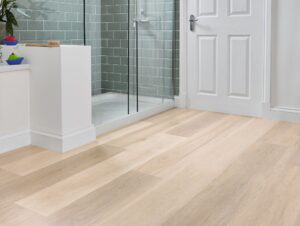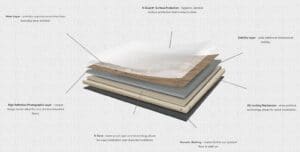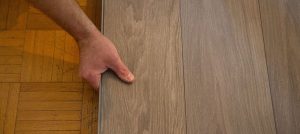If you have been looking for a new timber-looking floor for your home, then you are likely to have come across many different options to choose from. These may include, for example, engineered timber, vinyl and laminate, glue down vinyl planks, or loose lay vinyl flooring; additionally, you probably keep hearing all about hybrid flooring.
You might think to yourself, what is hybrid flooring? Since it’s a hybrid, what does it combine? Would this be a suitable flooring option for my home? Why is everyone talking about it?
If so, all you need to do is keep reading – we will help you gain a better understanding of hybrid flooring by providing the answers to these questions.
What Is Hybrid Flooring?
 Hybrid flooring is a beneficial combination of two popular types – laminate and vinyl flooring.
Hybrid flooring is a beneficial combination of two popular types – laminate and vinyl flooring.
Both laminate and vinyl planks have been around for many years, thus have been installed in countless homes. While both can look and feel great, and many people have been perfectly happy with their choice, laminate or vinyl floors are not the best fit for everyone and for all purposes.
Laminate planks can be installed without gluing them to your subfloor, which is advantageous, but it comes with a cost; laminate flooring swells along the joints when it gets wet, even from mopping, overwatering pot plants or a spilt drink. As such, it’s not waterproof, and for that reason, it cannot be installed in many places.
On the other hand, vinyl flooring can withstand getting wet but require you to glue the planks down to your floor, which can make them harder to replace.
You get hybrid flooring by combining the best attributes of both these products without their drawbacks. Hybrid floors are designed to be installed easily as a floating floor (like laminate flooring) but can also withstand wetness (like vinyl floors).
The key difference between hybrid flooring and laminate planks is in the construction. The core of laminate flooring is composed of a compressed fibre (such as MDF or HDF), which swells when it gets wet. Most hybrid floors, in turn, are constructed from a stone polymer or other inert polymer core. The full construction includes many layers – the acoustic backing, specialised core, stability layers, high definition image layer, wear layer and finally, various protective surface coats. Just like laminate flooring, hybrid flooring has different interconnecting locking systems to allow easy installation.
Hybrid flooring Installation
 Hybrid flooring is specially designed to be quick and easy to install – more than most other hard flooring types.
Hybrid flooring is specially designed to be quick and easy to install – more than most other hard flooring types.
The first step is to remove any unsuitable existing floor coverings and ensure that the subfloor is smooth and level. To allow for expansion, skirtings might need to be removed, unless matching edge trims are to be used.
The planks are laid row by row, clicking together; sometimes, they might need a light tap with a rubber mallet, making sure to leave expansion gaps to the perimeter as required.
Once the hybrid floor is laid, any edge trims at doorways or across larger rooms can be installed.
Lastly, you can reinstall your skirting or edge trims along the perimeter.
(Please note that this is only a quick overview of the installation; each product will have a full in-depth installation guide.)
Hybrid Flooring FAQs
What Are the Advantages of Hybrid Flooring?
-
- Hybrid flooring is easy to install, and the effect is always smoother. Plus, there’s no need for an adhesive, as it’s installed with a locking system, and it reduces subfloor preparation.
- Hybrid floors are highly resistant to heat, making them perfect for warmer Australian climates.
- It’s waterproof and resistant to temperature changes, so it’s the perfect choice for water-prone indoor areas (e.g., a bathroom). This feature also facilitates maintenance.
- Hybrid floors look and feel better. Thanks to the layers, they offer a softer sound and a cushion underfoot.
- Due to the used materials (mostly a mix of plastic with wood or limestone), hybrid flooring ensures excellent aesthetics for an affordable price.
- The hybrid floor is incredibly hard-wearing – it can withstand high foot traffic, plus, they are also children and pet-friendly.
How to Clean Hybrid Flooring?
As hybrid flooring is waterproof, it’s enough to use water and a PH neutral cleaner for a routine cleaning – simply use a damp mop, sponge, or cloth; a steam mop is not recommended. For dirt and dust, it’s safe to sweep your hybrid floor with a soft broom or to vacuum.
Make sure not to scratch it (e.g., with nylon scouring pads) and don’t use any strong chemicals, oils, soaps, or waxes.
What Rooms Are Best for Hybrid Flooring?
Because they look like real timber flooring, hybrid floors can be used in virtually all indoor spaces, as they will always look stylish. They are also highly resistant, so can be even installed where there are pets, children, or high foot traffic.
Moreover, considering that hybrid flooring is waterproof, it is very often chosen for water-prone spaces, such as kitchens, bathrooms, dining rooms, laundries, entryways, and so on.
Can I Use Hybrid Flooring Outside?
Though hybrid floors are pretty hard-wearing, they aren’t designed to withstand adverse weather conditions and other potentially damaging elements, so they shouldn’t be installed outdoors. Most likely, it will make your hybrid flooring warranty invalid.
Can Hybrid Flooring Scratch?
Even though hybrid floors are highly resistant and durable, they aren’t 100% indestructible and can get scratched. To avoid it, make sure all furniture and other items on the floor have gliders or felt pads, don’t use abrasive cleaners and regularly remove any dirt that could damage the flooring.
Fortunately, minor scratches can be dealt with – all you need is a little scratch cover oil.
Conclusion:
To put it simply, hybrid flooring is a hybrid of laminate and vinyl planks to give you the benefits of both in a single type of flooring, without the pitfalls.
Now that you have a better understanding of what hybrid flooring is, you may be wondering if this is the right choice for your home. If you are after a floor that looks like a real timber flooring, but you don’t want to worry about easily damaging the surface or swelling if it gets wet, then this product might be perfect for you.
Additionally, if you are looking at DIY installation of this product, but you are concerned it might be a little tricky for you, don’t hesitate to contact us. We will gladly go through more details of what is required for installation or even recommend another product that may be easier for you to install.
This is a great video of a hybrid flooring installation:
